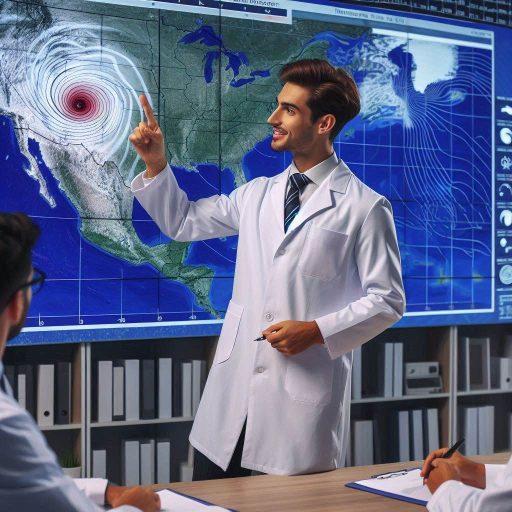Introduction
Weather phenomena play a crucial role in shaping our environment and daily lives.
Among the most powerful and destructive of these phenomena are hurricanes and tornadoes.
Understanding these weather events is essential for preparedness and safety, as they can cause significant damage to communities and disrupt lives.
Hurricanes are massive storms that form over warm ocean waters, bringing strong winds and heavy rainfall.
In contrast, tornadoes are rapidly rotating columns of air that can develop from thunderstorms, often resulting in intense wind speeds.
In this post, we will explore the characteristics, formation, and impacts of hurricanes and tornadoes.
We will discuss the differences between these two weather phenomena and highlight the importance of understanding their behavior.
Additionally, we will provide safety tips and preparedness strategies to help you stay safe during severe weather events.
By the end of this post, you will have a deeper understanding of hurricanes and tornadoes and how to protect yourself and your loved ones.
What are Hurricanes?
Definition of Hurricanes
Hurricanes are powerful tropical storms that can cause widespread destruction.
They form over warm ocean waters, typically near the equator.
These storms are characterized by strong winds and heavy rain.
Formation of Hurricanes
Hurricanes begin as a cluster of thunderstorms that organize around a low-pressure center.
As warm, moist air rises, it creates a vacuum that draws in more air from the surrounding area.
This process continues, allowing the storm to grow and intensify.
Hurricanes typically form between June and November in the Atlantic Ocean.
During this time, warm ocean waters provide the necessary energy for development.
Meteorologists closely monitor tropical storm activity during hurricane season.
They use satellite imagery and weather models to predict storm paths and intensities.
Different Categories of Hurricanes
Hurricanes are categorized into five distinct levels based on their wind speeds.
The Saffir-Simpson Hurricane Wind Scale classifies them into these categories.
A Category 1 hurricane has winds between 74 and 95 mph.
A Category 2 hurricane has winds from 96 to 110 mph.
Category 3 storms, known as major hurricanes, have winds ranging from 111 to 129 mph.
Category 4 hurricanes have winds between 130 and 156 mph, while Category 5 hurricanes exceed 157 mph.
Typical Characteristics of Hurricanes
Typical characteristics of hurricanes include a well-defined eye at their center.
The eye is a calm area surrounded by the eyewall, where the strongest winds and heaviest rains occur.
The eyewall consists of thick clouds that produce intense rainfall and severe winds.
Outside the eyewall, the storm exhibits spiral rain bands that extend outward, bringing rain and wind far from the storm‘s center.
Hurricanes can vary significantly in size and intensity.
Some hurricanes cover several hundred miles, while others are much smaller.
The size often influences the extent of damage they can cause.
Strong hurricanes can produce storm surges that flood coastal areas, causing significant property damage.
Additionally, heavy rainfall can lead to inland flooding, affecting communities far from the coastline.
The impacts of hurricanes can be devastating.
High winds can destroy buildings, uproot trees, and disrupt power lines.
Storm surges can inundate coastal communities, causing evacuations and destruction.
Flooding can lead to loss of life and property, making hurricanes one of nature‘s most dangerous phenomena.
Understanding hurricanes helps communities prepare and respond effectively.
Awareness of their characteristics and potential impacts can save lives.
Preparation includes having an emergency plan and supplies ready before a storm approaches.
This proactive approach can significantly reduce the risks associated with these powerful storms.
Impact of Hurricanes
Destruction Caused by Hurricanes
Hurricanes cause significant destruction through high winds, heavy rainfall, and storm surges.
Winds can exceed 157 mph in Category 5 hurricanes, uprooting trees and demolishing buildings.
These powerful storms can obliterate homes, schools, and infrastructure, leaving communities in ruins.
Storm surges, which occur when hurricane winds push ocean water ashore, can flood coastal areas.
This flooding can wash away roads and damage critical facilities like hospitals and power plants.
Heavy rainfall can lead to severe inland flooding, impacting areas far from the coast.
Economic Impact on Communities
The economic impact of hurricanes on communities can be devastating.
Damage repair costs can run into billions of dollars.
Local economies suffer as businesses close and jobs are lost during and after storms.
Additionally, long-term recovery can strain community resources and disrupt local economies.
Many businesses may take months or years to recover, leading to ongoing financial challenges for residents.
Insurance claims can overwhelm companies, leading to increased premiums and potential financial instability.
Human Toll of Hurricanes
The human toll of hurricanes is often the most tragic aspect.
Lives are lost due to flooding, falling debris, and other storm-related incidents.
Evacuations can be chaotic, leaving many vulnerable and unprepared.
Displacement from homes leads to emotional and psychological trauma for survivors.
Communities can face long-term impacts, including mental health issues, loss of community cohesion, and increased poverty levels.
The recovery process can take years, affecting entire generations.
Examples of Devastating Hurricanes in History
Several hurricanes throughout history highlight the destructive power of these storms.
Hurricane Katrina in 2005 devastated New Orleans, resulting in over 1,800 fatalities and billions in damages.
The storm caused catastrophic flooding, displacing thousands.
Hurricane Harvey struck Texas in 2017, bringing unprecedented rainfall and flooding, causing over $125 billion in damages.
Hurricane Maria hit Puerto Rico in 2017, leading to a humanitarian crisis.
It caused significant loss of life and destroyed critical infrastructure.
The recovery from these disasters highlighted the vulnerabilities of communities and the need for better preparedness.
Hurricanes leave a profound impact on both physical environments and human lives.
Understanding the various impacts helps communities prepare for future storms.
Awareness and preparedness can mitigate damage and save lives when hurricanes strike.
Read: Women in Botany: Celebrating Pioneers and Leaders
Forecasting Hurricanes
Methods Used to Track Hurricanes
Forecasting hurricanes involves several methods to track their development and movement.
Meteorologists use satellite imagery to observe cloud patterns and storm systems over vast ocean areas.
This imagery helps identify potential hurricane formations.
Additionally, weather radar provides real-time data on precipitation and wind speeds as storms approach land.
Surface observations from buoys and ships contribute valuable information about ocean temperatures and atmospheric conditions.
By combining these methods, meteorologists can monitor hurricanes more accurately and predict their paths.
Technology Involved in Predicting Hurricane Paths
Advanced technology plays a crucial role in predicting hurricane paths.
Numerical weather prediction models use complex algorithms to simulate atmospheric conditions.
These models analyze data from various sources, including satellites, radars, and weather stations.
The data helps generate forecasts that predict a hurricane’s intensity and track.
Doppler radar technology allows meteorologists to measure wind speeds and detect rotation in storm systems.
Moreover, hurricane reconnaissance aircraft gather data directly from within the storm, providing critical insights into its structure and strength.
Role of Meteorologists in Forecasting Hurricanes
Meteorologists play a vital role in forecasting hurricanes and communicating risks to the public.
They analyze data from various sources to understand storm behavior and predict future developments.
Their expertise allows them to interpret complex models and make informed forecasts.
Meteorologists also issue warnings and advisories to help communities prepare for incoming storms.
They work closely with government agencies to coordinate emergency response efforts, ensuring that accurate information reaches those in harm’s way.
Importance of Early Warning Systems
Early warning systems are crucial in minimizing the impact of hurricanes.
These systems provide timely alerts about storm development and potential threats to communities.
With accurate forecasts, residents can prepare for evacuations and secure their homes.
Early warnings help authorities mobilize resources and emergency services before a hurricane strikes.
This proactive approach can significantly reduce loss of life and property damage.
Furthermore, community awareness of hurricane preparedness fosters resilience and enhances overall safety.
Forecasting hurricanes relies on a combination of advanced technology, skilled meteorologists, and effective communication.
These elements work together to track and predict hurricane behavior, providing essential information to communities at risk.
The importance of early warning systems cannot be overstated, as they save lives and help mitigate damage.
As technology continues to advance, hurricane forecasting will become even more accurate and reliable.
Read: How Climate Change Is Impacting Plant Research
What are Tornadoes?
Definition of Tornadoes
Tornadoes are rapidly rotating columns of air that extend from thunderstorms to the ground.
They are often visible as a funnel-shaped cloud.
Tornadoes can vary in size, shape, and intensity.
They are among nature’s most violent weather phenomena, capable of causing widespread destruction.
Formation of Tornadoes
Tornadoes typically form from severe thunderstorms known as supercells.
These thunderstorms have a rotating updraft called a mesocyclone.
When warm, moist air rises, it can create an unstable atmosphere.
As this warm air meets cooler air aloft, the contrast can trigger the formation of a tornado.
Wind shear, which is the change in wind speed and direction with altitude, also contributes to tornado formation.
When the rotating updraft tilts vertically, it can develop into a tornado.
Different Types of Tornadoes
Tornadoes can be classified into several types based on their characteristics.
The most common type is the funnel tornado, which has a narrow, funnel-shaped appearance.
Waterspouts are tornadoes that form over water and can transition onto land.
Landspouts are similar to funnel tornadoes but form from non-supercell thunderstorms.
There are also dust devils, which are weaker, short-lived whirlwinds that occur on clear, hot days.
Lastly, the EF scale classifies tornadoes based on their damage, ranging from EF0 (weakest) to EF5 (strongest).
Characteristics of Tornadoes
Tornadoes exhibit distinct characteristics that differentiate them from other weather phenomena.
They can have wind speeds ranging from 40 mph to over 300 mph.
The average tornado lasts only a few minutes, but some can persist for over an hour.
Tornadoes can vary in width, with some being as narrow as a few feet and others exceeding a mile.
The appearance of a tornado can change rapidly, sometimes displaying a visible condensation funnel, debris cloud, and surrounding cloud base.
Tornadoes often accompany severe thunderstorms and can produce heavy rainfall and hail.
Their paths of destruction can be unpredictable, making them particularly dangerous.
Tornadoes can cause severe damage to buildings, uproot trees, and toss vehicles.
Tornadoes are complex and powerful weather phenomena that require careful monitoring and study.
Understanding their formation and characteristics helps communities prepare for these dangerous storms.
Awareness of tornado risks can save lives and minimize property damage.
Continuous advancements in meteorological research enhance our ability to predict and respond to tornado events.
Read: Exploring the Different Branches of Geology
Transform Your Career Today
Unlock a personalized career strategy that drives real results. Get tailored advice and a roadmap designed just for you.
Start Now
Impact of Tornadoes
Damage Caused by Tornadoes
Tornadoes can cause extensive damage in a matter of minutes.
Their high winds can destroy buildings, uproot trees, and flip vehicles.
Tornadoes can tear roofs off homes and level entire neighborhoods.
The debris created during a tornado can become dangerous projectiles, causing additional destruction and injury.
The aftermath often leaves communities reeling, with critical infrastructure such as power lines and roads severely impacted.
Recovery can take years, as residents work to rebuild their lives and homes.
Difference in Destruction Between Hurricanes and Tornadoes
While both hurricanes and tornadoes are destructive, their impacts differ significantly.
Hurricanes can span hundreds of miles and last for days, bringing heavy rains, storm surges, and high winds.
Their widespread nature causes prolonged damage over large areas.
In contrast, tornadoes are localized phenomena, often affecting specific neighborhoods or towns.
However, tornadoes can produce much stronger winds, leading to more intense destruction in their immediate paths.
Tornadoes generally cause quicker, more concentrated damage, while hurricanes inflict widespread but sometimes less intense destruction over a longer period.
Vulnerable Areas for Tornadoes
Certain areas are more susceptible to tornadoes, particularly in the United States.
The region known as “Tornado Alley,” which includes parts of Texas, Oklahoma, Kansas, and Nebraska, experiences the highest frequency of tornadoes.
The unique geography and climate in these areas create ideal conditions for tornado formation.
However, tornadoes can occur in many states outside of this region, especially during severe thunderstorms.
The unpredictability of tornado paths makes it essential for residents in vulnerable areas to stay informed and prepared.
Stories of Communities Affected by Tornadoes
Many communities have faced devastation due to tornadoes, leaving lasting impacts on residents.
In 2011, Joplin, Missouri, was hit by a powerful EF5 tornado.
The storm killed over 150 people and destroyed thousands of homes.
Recovery efforts took years, but the community demonstrated resilience and unity in rebuilding.
Another example is the town of Moore, Oklahoma, which has experienced multiple tornadoes, including a catastrophic EF5 in 2013.
This tornado caused significant damage to schools, homes, and businesses, leading to increased awareness about tornado preparedness and response.
The stories of communities affected by tornadoes often highlight the importance of emergency preparedness and response.
Many survivors share their experiences to raise awareness and promote safety measures.
These narratives foster a sense of community and encourage individuals to take action in the face of potential disasters.
Tornadoes have a profound impact on communities, causing immediate destruction and long-term challenges.
Understanding their destructive capabilities, vulnerable areas, and the stories of affected communities can help improve preparedness and response efforts.
Increased awareness and education can save lives and mitigate damage when tornadoes strike.
Read: Top Skills Needed for a Successful Geology Career
Learn More: Nuclear Science in National Security
Explore Further: Career Switch to Bioinformatics: What You Need to Know
Forecasting Tornadoes
Challenges in Predicting Tornadoes
Forecasting tornadoes poses significant challenges due to their unpredictable nature.
Tornadoes can develop rapidly, often with little warning, making them difficult to track.
Meteorologists rely on specific atmospheric conditions to predict tornado formation, but these conditions can change quickly.
The short lifespan of tornadoes, often just a few minutes, adds to the difficulty in forecasting.
Additionally, the localized nature of tornadoes means that while one area may be at risk, another nearby may be safe.
These uncertainties make accurate predictions challenging, leading to the need for constant vigilance and monitoring.
Tools and Technology Used in Tornado Forecasting
Meteorologists use advanced tools and technology to improve tornado forecasting.
Doppler radar is one of the most crucial technologies, as it provides real-time data on wind speed and storm rotation.
This information helps identify potential tornado formation.
Satellite imagery also plays a role, allowing meteorologists to observe weather patterns and storm development over vast areas.
Additionally, weather models simulate atmospheric conditions, aiding in the prediction of tornado likelihood.
Storm chasers and reconnaissance aircraft collect valuable data directly from severe storms, enhancing forecasting accuracy.
How Meteorologists Analyze Conditions for Tornado Formation
Meteorologists analyze various atmospheric conditions to assess the potential for tornado formation.
They look for signs of instability in the atmosphere, such as warm, moist air near the surface and colder, drier air aloft.
Wind shear, or the change in wind speed and direction with height, is another critical factor.
Meteorologists often monitor severe thunderstorm warnings, as these storms can produce tornadoes.
By studying the interplay of these conditions, they can identify environments conducive to tornado development.
Importance of Tornado Watch and Warning Systems
Tornado watch and warning systems are vital for public safety.
A tornado watch indicates that conditions are favorable for tornadoes to form, giving communities time to prepare.
During a watch, residents should stay informed and ready to take action.
A tornado warning, on the other hand, signifies that a tornado has been spotted or detected by radar.
Warnings prompt immediate action, as tornadoes can occur within minutes.
Effective communication of these alerts is essential for ensuring public safety.
Weather agencies utilize multiple platforms, including television, radio, and mobile alerts, to disseminate information quickly.
Communities that understand the importance of these systems can take appropriate precautions, reducing the risk of injury and loss of life.
Forecasting tornadoes involves navigating numerous challenges, but advancements in technology and meteorological analysis enhance prediction efforts.
Understanding tornado formation and the importance of watch and warning systems can significantly improve community preparedness.
Increased awareness and timely information are crucial for ensuring safety when tornadoes threaten.
Safety Precautions for Hurricanes and Tornadoes
Difference in Safety Measures for Hurricanes and Tornadoes
The safety measures for hurricanes and tornadoes differ due to their unique characteristics.
Hurricanes are large, slow-moving storms that can cause prolonged rainfall, high winds, and flooding.
As such, safety measures for hurricanes often focus on preparation and evacuation.
Residents are encouraged to secure their homes, stock up on supplies, and have an evacuation plan.
In contrast, tornadoes are fast and unpredictable, requiring immediate action.
Safety measures for tornadoes emphasize seeking shelter quickly.
Individuals should move to a basement or interior room away from windows, ideally in a sturdy building.
Tips for Preparing for a Hurricane or Tornado
Preparing for hurricanes and tornadoes involves several critical steps.
For hurricanes, residents should create an emergency kit containing water, non-perishable food, flashlights, batteries, and a first-aid kit.
It‘s essential to secure outdoor items that can become projectiles during storms.
People should also stay informed by monitoring weather updates and following guidance from local authorities.
For tornadoes, having a designated safe area in the home is crucial.
This space should be away from windows and ideally located in a basement or storm cellar.
Additionally, families should practice tornado drills to ensure everyone knows where to go during a storm.
Keeping a weather radio handy can help individuals stay informed of any tornado warnings.
Importance of Having a Safety Plan in Place
Having a safety plan in place is vital for protecting lives during hurricanes and tornadoes.
A well-communicated plan ensures that everyone in the household knows what to do and where to go in an emergency.
Families should discuss their safety plan regularly and update it as necessary.
This plan should include evacuation routes, emergency contacts, and meeting places.
A clear understanding of safety measures reduces panic and confusion during a crisis, leading to more effective responses and increased safety.
Evacuation Procedures for Hurricanes and Tornadoes
Evacuation procedures vary significantly between hurricanes and tornadoes.
For hurricanes, local authorities often issue evacuation orders days in advance, allowing residents time to leave safely.
Individuals should familiarize themselves with evacuation routes and transportation options.
It‘s important to plan for pets and ensure that all family members are accounted for during evacuation.
In contrast, tornadoes can strike with little warning, leaving little time for evacuation.
Instead of evacuating, people should seek shelter immediately in a safe location.
If outside and unable to reach shelter, lying flat in a low-lying area, such as a ditch, can help protect against debris.
Safety precautions for hurricanes and tornadoes require different approaches.
Understanding these differences and preparing accordingly can save lives.
Developing a comprehensive safety plan and practicing evacuation procedures can significantly enhance community resilience and readiness in the face of severe weather events.
Find Out More: Advancements in Meteorological Instruments and Tools
You Might Also Like: How to Become a Microbiologist: Step-by-Step Guide
Conclusion
Hurricanes and tornadoes pose significant threats to communities worldwide.
Hurricanes are large, rotating storms that form over warm ocean waters.
These powerful storms can bring devastating winds, heavy rainfall, and flooding to coastal areas.
The impact of a hurricane can last for weeks or even months.
Tornadoes, on the other hand, are smaller but often more intense.
These rapidly rotating columns of air can generate winds exceeding 300 miles per hour, capable of destroying buildings in seconds.
Understanding these weather phenomena is crucial for effective preparedness and response.
Knowledge of hurricane and tornado formation enables individuals and communities to implement safety measures.
It is essential to monitor weather forecasts during storm season, especially in areas prone to these events.
Communities should develop emergency plans and ensure that residents know evacuation routes and safe locations.
Staying informed through reliable sources, like the National Weather Service, can provide timely updates during severe weather events.
Local alerts and warnings can help individuals take immediate action to protect themselves and their property.
Preparing an emergency kit with essential supplies can also be beneficial.
This kit should include water, non-perishable food, medications, flashlights, batteries, and important documents.
[E-Books for Sale]
The Big Book of 500 High-Paying Jobs in America: Unlock Your Earning Potential
$19.99 • 500 High-Paying Jobs • 330 pages
Explore 500 high-paying jobs in America and learn how to boost your career, earn more, and achieve success!
See All 500 High-Paying Jobs of this E-Book
1001 Professions Without a Degree: High-Paying American Jobs You Can Start Now
$19.99 • 1001 Professions Without a Degree • 174 pages
Discover 1001 high-paying jobs without a degree! Unlock career tips, skills, and success strategies for just $19.99!




